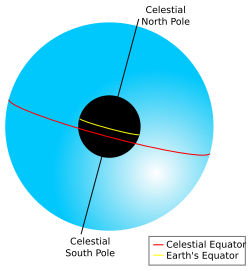Celestial sphere


In astronomy and navigation, the celestial sphere is an imaginary sphere (ball) of a very large unspecified size. The earth and the sphere have the same centre: they are concentric. They also rotate upon the same axis. All objects in the sky can be thought of as projected (drawn, written) upon the celestial sphere. This imaginary sphere is a very practical tool for positional astronomy.
Celestial hemispheres
The equator divides the earth into the Northern Hemisphere and the Southern Hemisphere. Similarly, the celestial sphere is divided by projecting the equator into space. This divides the sphere into the north celestial hemisphere and the south celestial hemisphere. One can also locate the Celestial Tropic of Cancer, Celestial Tropic of Capricorn, North Celestial Pole, and South Celestial Pole.
Sidereal time
The Earth rotates from west to east around its axis in slightly less than 24 hours.[1] The celestial sphere and all objects on it appear to rotate from east to west around the celestial poles in the same time. This is the diurnal motion (daily motion). This is why stars will rise in the east and set in the west, (unless a star is circumpolar). On the next night a particular star will rise again, but with our normal clocks running a 24-hour 0-minute cycle, it will do so slightly less than 4 minutes earlier. By the following night the difference will be 8 minutes, and so forth with every following night (or day).
The reason for this is that the Sun does not stand still on the celestial sphere, and the stars do (except for a tiny proper motion). The sun moves about 1° per day eastwards over a great circle known as the ecliptic (which is 360° or a full circle in one year, the annual motion of the Sun). As an angle of 1° corresponds to 4 minutes in time (360° = 24 hours), we need therefore four extra minutes of diurnal motion to see the Sun back on the same meridian again, making the duration of one rotation just 24 hours exactly (on the average, ignoring small seasonal variations, see equation of time)
Normal clocks therefore indicate solar time. Astronomers studying the movements of stars may want clocks indicating sidereal time, going around once in 23h56m (solar time units).
Star globe

A celestial sphere can also refer to a physical model of the celestial sphere or celestial globe. Such globes map the constellations on the outside of a sphere, resulting in a mirror image of the constellations as seen from Earth. The oldest surviving example of such an artefact is the globe of the Farnese Atlas sculpture, a 2nd-century copy of an older (Hellenistic period, ca. 120 BC) work.
Celestial Sphere Media
References
- ↑ It averages once every 23 hours, 56 minutes, 4.0916 seconds.
- Bowditch, Nathaniel (2002). The American Practical Navigator. Bethesda, MD: National Imagery and Mapping Agency. ISBN 0939837544. Archived from the original on 2007-06-24. Retrieved 2011-04-04.
- MacEwen, William A.; William Hayler; Turpin, Edward A. (1989). Merchant Marine officers' handbook: based on the original edition by Edward A. Turpin and William A. MacEwen (5th ed.). Cambridge, Md: Cornell Maritime Press. pp. 46–51. ISBN 0-87033-379-8.
{{cite book}}: CS1 maint: multiple names: authors list (link)
Other websites
| Wikimedia Commons has media related to Lua error in Module:Commons_link at line 62: attempt to index field 'wikibase' (a nil value).. |
- SkyandTelescope.com SkyChart
- Monthly skymaps for every location on Earth Archived 2007-09-13 at the Wayback Machine
- Fixed pattern of distant stars, part of elementary astronomy course From Stargazers to Starships
